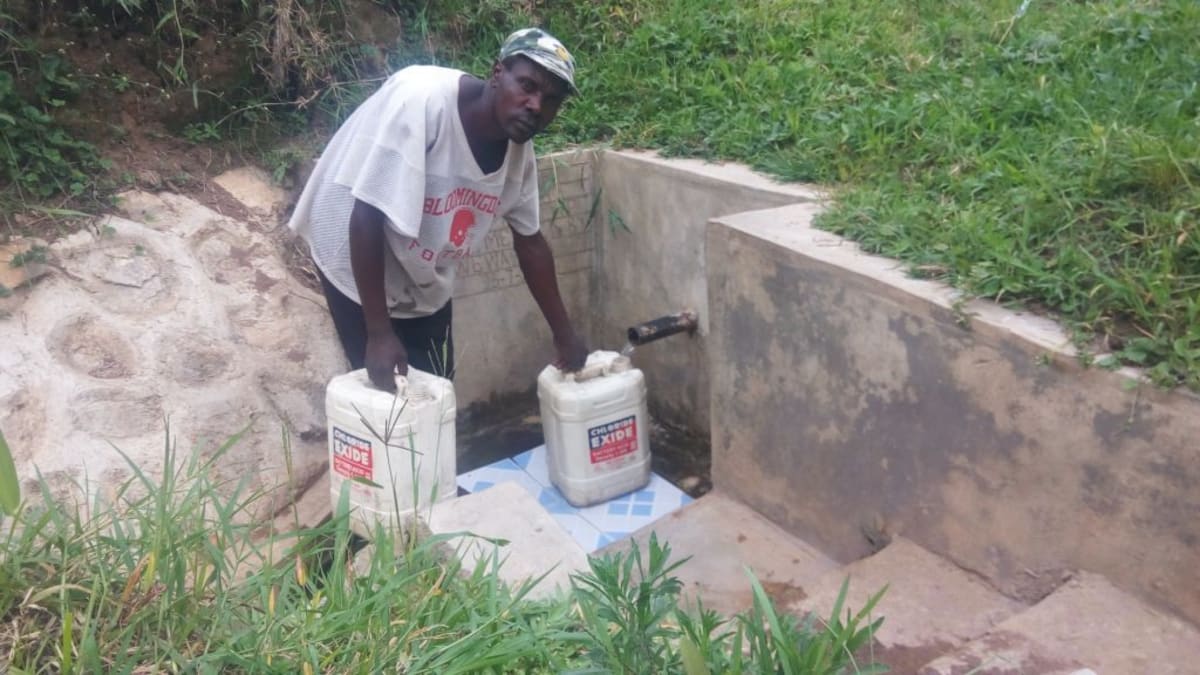This project is a part of our shared program with Western Water and Sanitation Forum (WEWASAFO). Our team is pleased to directly share the below report (edited for clarity, as needed).
Welcome to the Community
It’s in the wee hours of the morning that the community members within Bushevo Village wake up. They are seen walking to the spring to fetch water as early as 6 am.
In this community, most people are small-scale farmers who plant maize and beans for domestic use and sell whatever excess they harvest. Young adults between 25-30 years are most often motorbike riders who taxi others for a small fee. They are referred to as "piki piki" in this community.
Water Situation
Women with 20-liter jerrycans stream to David Enani Spring, and children are not left out - they are seen carrying smaller containers too. The women report that they make up to 10-14 trips per day. They use this water for cooking, laundering, watering animals and drinking.
The spring appears as a large puddle. Women and children either hold their jerrycan under the water until full or bring a smaller cup to bail water. Many locals were seen stepping into the water as they fetched, and animals are free to come and go as they are thirsty. There are also nearby farms that use chemicals that are washed into the water when it rains. Not only that, but many children seek the privacy of crops to relieve themselves - so most likely human waste is washed into the water source as well.
After delivered home, water is poured into open barrels for storage. The longer this water sits uncovered, the dirtier it becomes.
This community suffers from constant cases of waterborne disease. Small children and the elderly are those most affected by typhoid and its stomachache and diarrheal symptoms.
Sanitation Situation
Less than half of households have pit latrines. Most of those are made of mud, which often washes away with heavy rains. Because of these conditions, open defecation is a huge issue in this area - people are preferring the privacy of trees and bushes to proper facilities. This waste is then spread by animals, flies, and rainwater.
There are no hand-washing stations here, so essentially no safeguards against the spread of disease. Many families are even drying their eating utensils on the ground.
Mrs. Jampeher Musundi told us a bit about sickness in her own home, saying "If a month passes without the children getting sick, that is really a miracle as each and every day my three-year-old baby suffers diarrhea. And on many occasion, she was diagnosed of bacteriological infections. This has really affected her health and she really needs special attention and diet to recover."
Plans: Hygiene and Sanitation Training
Community members will attend hygiene and sanitation training for at least two days. This training will ensure participants are no longer ignorant about healthy practices and their importance. The facilitator plans to use PHAST (Participatory Hygiene and Sanitation Transformation), CLTS (Community-Led Total Sanitation), ABCD (Asset-Based Community Development), group discussions, handouts, and demonstrations at the spring.
Training will also result in the formation of a committee that will oversee operations and maintenance at the spring. They will enforce proper behavior around the spring and delegate tasks that will help preserve the site, such as building a fence and digging proper drainage.
Plans: Sanitation Platforms
On the final day of training, participants will select five families that should benefit from new latrines.
Training will also inform the community and selected families on what they need to contribute to make this project a success. They must mobilize locally available materials, such as bricks, clean sand, hardcore, and ballast. The five families must prepare by sinking a pit for the sanitation platforms to be placed over. All community members must work together to make sure that accommodations and food are always provided for the work teams.
Plans: Spring Protection
Fetching water is predominantly a female role, done by both women and young girls. Protecting the spring and offering training and support will therefore help empower the female members of the community by giving them more time and efforts to engage and invest in income-generating activities.
In addition, protecting the spring will ensure that the water is safe, adequate and secure. Construction will keep surface runoff and other contaminants out of the water.
Protecting this spring will result in increased water quality and water flow. Those living in Bushevo will thus be able to live happier, healthier lives as they efficiently fill their containers with clean water from David Enani Spring.

 Protected Spring
Protected Spring
 Rehabilitation Project
Rehabilitation Project






























